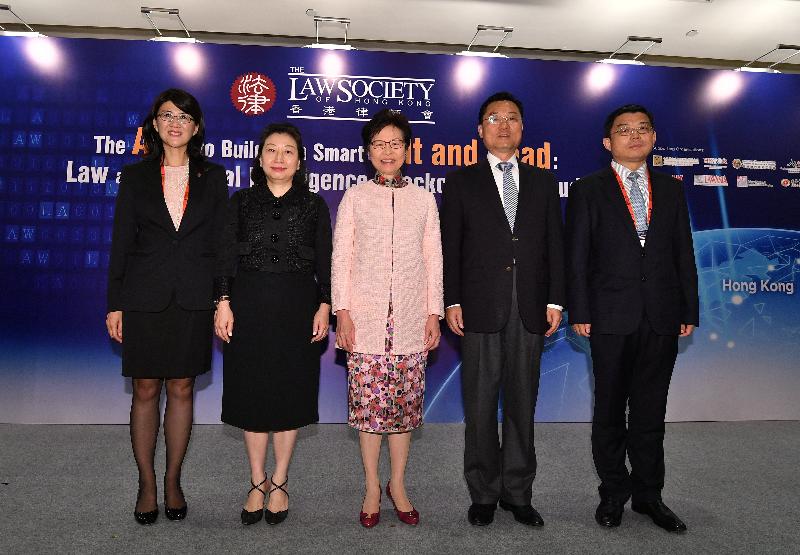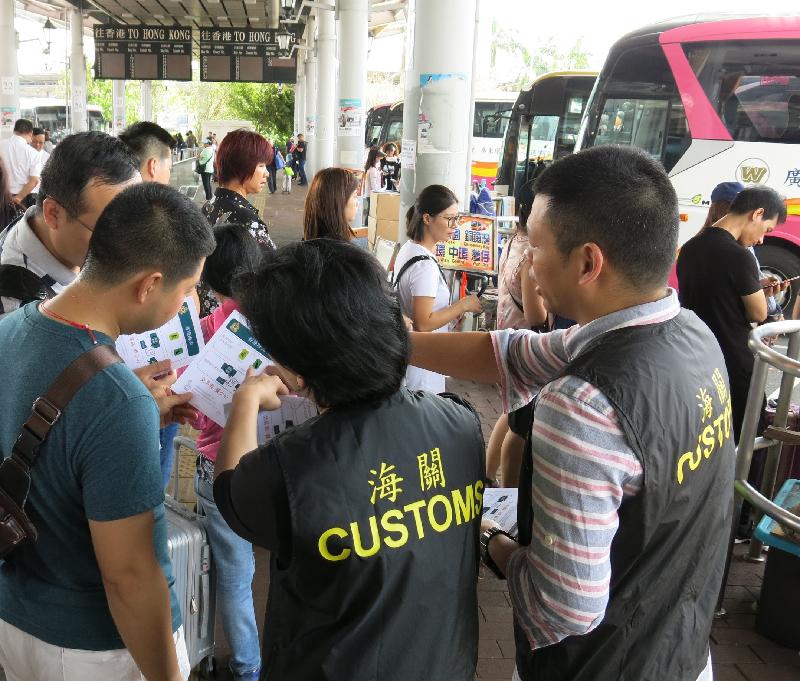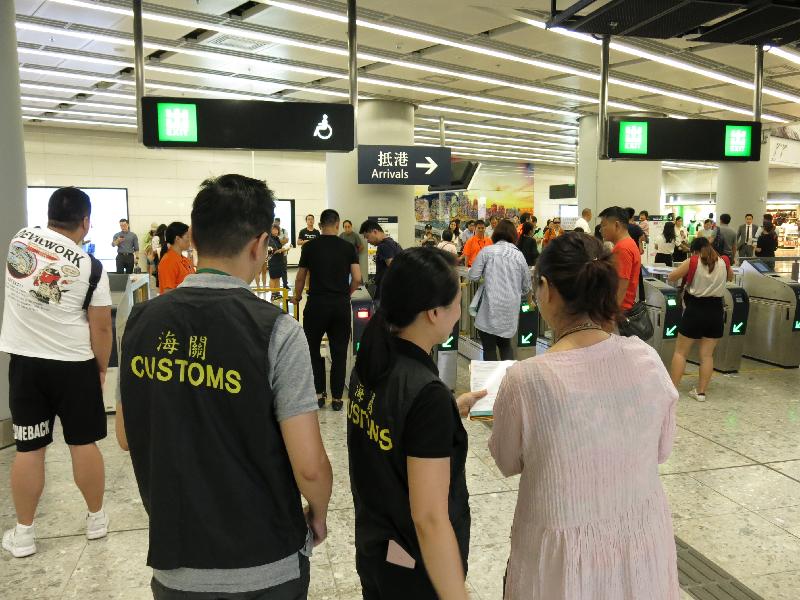Following is the speech by the Chief Executive, Mrs Carrie Lam, at the opening ceremony of the Belt and Road Conference today (September 28):
Commissioner Xie Feng (Commissioner of the Ministry of Foreign Affairs of the People's Republic of China in the Hong Kong Special Administrative Region), Melissa (President of the Law Society in Hong Kong, Ms Melissa Pang), ladies and gentlemen,
Good morning. I'm pleased to join you today for the Law Society's Belt and Road Conference. As we came in, Melissa thanked me for taking time out of my very busy schedule to attend today's event. That's true not because I am very busy attending a lot of functions, but with my annual Policy Address to be delivered in about 10 days' time, I am actually locking myself up to write my Policy Address, especially when one editorial in a Chinese newspaper yesterday said that since the Chief Executive has suffered a major setback in her popularity because of the aftermath of Super Typhoon Mangkhut, she'd better do a Policy Address that could recoup some of that loss. I also told Melissa that with a lady president of the Law Society, a historic one in Hong Kong, I feel duty-bound to support her and to come to today's event. Indeed, with a lady Secretary for Justice – although Teresa (Secretary for Justice, Ms Teresa Cheng, SC) has not made history as the first lady Secretary for Justice, the Honourable Elsie Leung, is in the audience – I feel doubly duty-bound to attend legal functions.
This is the Society's second conference devoted to the Mainland of China's far-reaching Belt and Road Initiative, highlighting its vast promise for the legal sector, for Hong Kong and for much of the world as well. I am pleased to note that today's conference has attracted over 650 professionals and more than 40 legal associations from nearly 20 countries and regions, all keen to get a better understanding and a competitive edge when it comes to law and technology in the building of the Belt and Road. I am also pleased to note that a concurrent event, the InnoTech Law Hackathon: Belt & Road Justice Challenge, which is organised by the Innotech Committee under the Law Society, will take place this afternoon. The event will focus on how technology can enhance access to justice in Belt and Road jurisdictions.
Technology will become increasingly critical to the success of the Belt and Road Initiative, which is all about enhancing connectivity between countries. Originally envisioned as encompassing Asia, Africa, the Middle East and Europe, it has now extended its vision and its reach to Latin America. Given its vast political and geographical magnitude, connectivity can only be enhanced efficiently with the help of technology.
When we talk about trade along the Belt and Road today, innovation and technology is inevitably part of that discussion, and it's fintech that increasingly dominates the conversation. Fintech can enable cost-effective financial services, while promoting cross-border trade and investment along the Belt and Road. Given its clear potential in lowering the cost of doing business, fintech promises a level playing field for business, and that can only spark further innovation.
Apart from fintech, lawtech is also becoming increasingly important. Hong Kong positions itself as the region's legal and dispute-resolution services hub and has been consistently rated as the one of the most preferred seats of arbitration outside Europe. What distinguishes Hong Kong is the rule of law, backed by the trusted common law system, the independence of our judiciary, and the abundance of well-qualified legal professionals. On the latter, some 900 local solicitor firms and about 85 local firms practice here. They are well versed in both the international and the Mainland's legal and regulatory landscape, and will most assuredly play a pivotal role in the progress of the Belt and Road Initiative.
Traditionally, legal practitioners handle highly confidential information in their daily work. Without mature technology in providing a watertight protection for information security, the legal industry was not among the first to embrace the digital transformation. But now, given the substantial and continuing advances in cloud security, the legal sector is increasingly seeking innovation with a view to capturing the time and cost savings there for the taking.
In addition to machine learning for legal research and AI-driven programmes for providing simple legal advice, efficient and effective online legal services have an enormous potential, particularly in the context of the Belt and Road Initiative where a large geographical area is covered. In anticipation of a rise in cross-border transactions as a result of the Initiative, private sector stakeholders in Hong Kong, including the Law Society, are already actively exploring the creation of an e-platform known as the eBRAM, that is the Belt and Road Arbitration and Mediation Centre, to facilitate the conclusion of transactions as well as dispute resolution. The group in charge of eBRAM came to see me a month ago asking for money and I tried to respond as positively as I could.
Also because of the wide geographical coverage of the Belt and Road, there are inevitably language barriers that have to be overcome in the course of co-operation. In fact, the Belt and Road region is home to more than a thousand languages and dialects. Translation technology and language databases will be in considerable demand to meet the needs for effective communication, particularly when it comes to contracts. I have been told that the eBRAM will also seek to address these issues. My Secretary for Justice will tell you more about this platform later this morning.
My Government has made innovation and technology a policy priority, which I believe will benefit all sectors, including the legal sector. Hong Kong's strengths lie in R&D, in technology adoption and start-ups and a deep talent pool. In terms of technologies, local universities and research institutions in Hong Kong possess strong capabilities in blockchain, AI, robotics, facial recognition and related fields. At the Hong Kong Science Park and Cyberport alone, some 300 tenants and incubatees focus on AI, robotics and data analytics.
AI technology is particularly important for the provision of online legal services. The Government will devote more resources to enhance Hong Kong's R&D and application capabilities in the AI field, train relevant talents and support technology start-ups to boost the development of AI technology in Hong Kong. On enhancing R&D capabilities, we have earmarked $10 billion in this year's Budget for setting up two research clusters to attract the world's top scientific research institutions and technology enterprises to Hong Kong for conducting more midstream and downstream R&D projects in collaboration with our local universities and scientific research institutions. One of the research clusters will focus on AI and robotics.
I am pleased to note that we do have some achievements on the AI front already. Last year, the Hong Kong University of Science and Technology became the first Asian institution admitted to the Partnership on AI to Benefit People and Society, an international consortium founded by such technology giants as Microsoft and Google to promote AI development. Just last week, SenseTime Group Limited, our home-grown unicorn, has been entrusted by the Ministry of Science and Technology of Mainland China to establish the "National Open Innovation Platform for Next Generation Artificial Intelligence on Intelligent Vision". And I have earlier announced that the renowned Institute of Automation under the Chinese Academy of Sciences has already agreed to join the aforementioned research cluster on AI and robotics.
The Government will also continue to fund R&D projects on AI through different schemes under the Innovation and Technology Fund. With the support of the Fund, the Hong Kong Applied Science and Technology Research Institute has been collaborating with different financial institutions to develop blockchain applications in areas like trade finance, mortgage, digital identity management and insurance. The Institute has also worked with local banks to develop a smart investment platform which provides investment options through the use of AI, big data analytics and machine learning programme calculations, and developed AI technology on reading different handwritten Chinese characters for enhancing the efficiency of document processing. I believe that, when the technologies have become mature, they will have the potential to be adopted in legal services as well.
To encourage enterprises to conduct more R&D activities, including those on AI, blockchain and cloud technologies, we will shortly introduce a new tax incentive under which their first $2 million of eligible R&D expenditure will enjoy a 300 per cent tax deduction and 200 per cent for the remainder. The relevant legislation has already been introduced into the Legislative Council and I hope that it will be passed sooner rather than later.
And we have a series of measures to attract and to nurture talent on innovation and technology. Among them is a pilot fast-track Technology Talent Admission Scheme which enables enterprises to attract overseas technology talent in focused technology areas, including AI and cybersecurity. In addition, we have launched a $500 million Technology Talent Scheme, including a Postdoctoral Hub, to provide funding support for enterprises to recruit postdoctoral talent for scientific research and product development. We will also subsidise enterprises to train their staff on high-end technologies.
We hope that all these efforts would create a conducive environment for innovation and technology development in Hong Kong. We would welcome the legal sector to join us and embrace innovation and technology, with a view to adding value to our existing business models. I am confident that innovation and technology, coupled with the quality, experience and expertise of our legal professionals, will make all the difference for Hong Kong and for the Belt and Road.
On that note, I wish you all a very rewarding conference, and a flourishing future built on innovation. Thank you very much.






